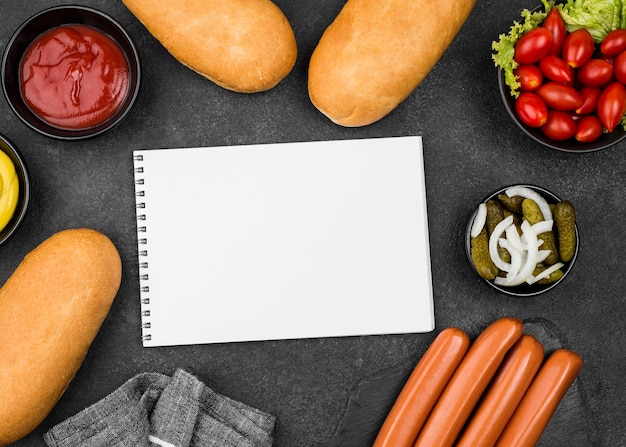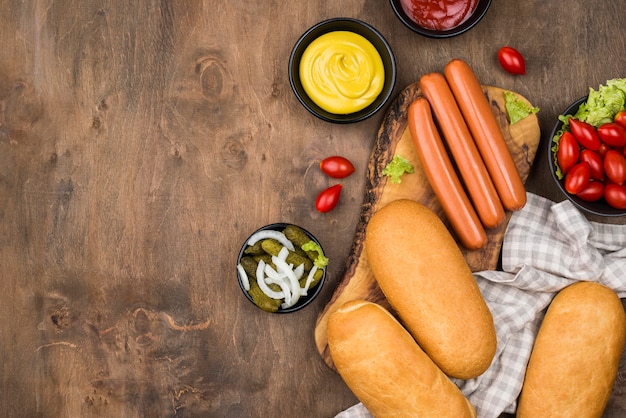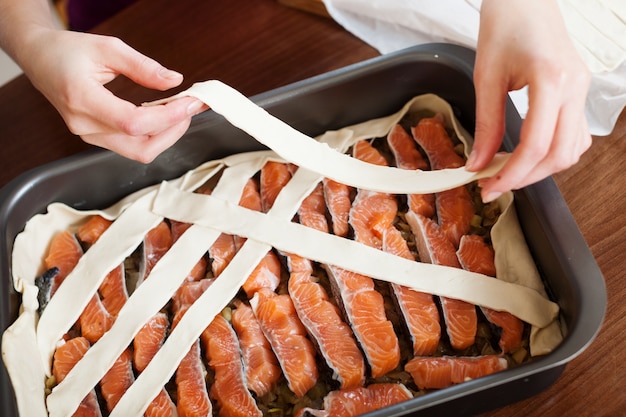As a lifelong devotee of the humble hot dog, I've embarked on countless culinary journeys in pursuit of the perfect bite. From backyard barbecues to gourmet hot dog stands, I've tasted my fair share of triumphs and, let's be honest, a few culinary disasters. But through it all, I've learned a thing or two about achieving hot dog nirvana. This guide isn't just about grilling; it's about understanding the art of crafting a truly satisfying hot dog experience. Join me as we delve into the world of hot dogs, uncovering the secrets to creating a masterpiece that will have you singing its praises.
(Part 1) Choosing the Right Dog: A Matter of Preference

The journey begins with the foundation: the hot dog itself. It's the heart of the matter, and choosing the right one sets the stage for the culinary adventure that awaits. There's a world of options out there, from classic all-beef franks to gourmet varieties boasting exotic ingredients. My advice? Don't be afraid to experiment! The hot dog world is your oyster, and it's an exciting time to be a hot dog enthusiast!
The All-American Classic: Beef Franks
For purists, a good old-fashioned beef frank is the way to go. These dogs are typically made with a blend of beef and pork, seasoned with a touch of spice. They offer a satisfyingly juicy and flavorful bite, perfect for traditional toppings like mustard, ketchup, and relish. They're the quintessential American hot dog, the one we all grew up with, the one that evokes memories of summer barbecues and family gatherings.
Exploring Beyond the Beef: Chicken, Turkey, and Beyond
But the world of hot dogs doesn't stop at beef. If you're looking for a lighter option or want to branch out, chicken or turkey hot dogs are a great choice. They tend to be lower in fat and calories, while still delivering a delicious taste. And then there's a whole world of specialty hot dogs made with ingredients like lamb, chorizo, or even vegetarian alternatives. It's an exciting time to be a hot dog enthusiast!
The Importance of Quality: Look for Natural and High-Quality Ingredients
One thing I've learned is that quality matters. Opt for hot dogs with natural ingredients, avoiding those laden with artificial flavors, preservatives, and fillers. Think about it – you wouldn't use cheap ingredients for a delicious cake, would you? The same principle applies to hot dogs. Trust me, your taste buds will thank you.
(Part 2) Grilling to Perfection: Mastering the Technique

Now that you've chosen your hot dogs, it's time to get grilling. This is where the real magic happens. It's the moment the hot dog transforms from a simple sausage into a culinary masterpiece.
The Art of Grilling: Direct Heat vs. Indirect Heat
There are two main approaches to grilling hot dogs: direct heat and indirect heat. Both have their advantages, and the choice depends on your desired outcome. Direct heat involves grilling the dogs directly over the flames, which creates a nice char and crispy exterior. It's the classic approach, the one that delivers that smoky, charred flavor we all love. Indirect heat involves grilling the dogs over a bed of coals, which results in a more evenly cooked and less charred hot dog. It's a gentler approach, ideal for those who prefer a less charred exterior.
Direct Heat: For a Crispy Exterior and Smoky Flavor
For a classic, smoky flavor, I prefer direct heat. It's the way my dad used to grill hot dogs, and the taste brings back so many happy memories. I usually place the hot dogs over medium-high heat, ensuring they get a good char without burning. Rotate them every few minutes to ensure even cooking.
Indirect Heat: For a More Even Cook and Tender Interior
If you want a more evenly cooked hot dog with a tender interior, indirect heat is the way to go. Place the hot dogs over a bed of coals, ensuring they're not directly over the flames. This method takes a bit longer, but it allows the hot dog to cook more gently, resulting in a tender, juicy interior.
(Part 3) Unleashing the Flavors: Toppings and Condiments

The beauty of the hot dog lies in its versatility. It's a blank canvas, ready to be transformed by a symphony of flavors. Whether you prefer a classic combination or something more adventurous, there's a topping for every palate.
The Classics: Mustard, Ketchup, and Relish
Let's face it, a good old-fashioned hot dog with mustard, ketchup, and relish is a timeless classic. The tangy mustard, sweet ketchup, and crunchy relish create a delightful symphony of flavors. It's simple, it's satisfying, and it's a taste that never gets old.
Beyond the Basics: Explore a World of Flavor
But don't limit yourself to the classics! There's a whole world of toppings out there waiting to be explored. Think about adding a dollop of chili, a sprinkle of cheese, or a spoonful of sauerkraut for a unique twist. The possibilities are endless, and you can create a flavor profile that perfectly suits your taste.
The Art of Pairing: Finding the Perfect Harmony
When choosing toppings, it's essential to consider the flavor profile of your hot dogs. For example, a spicy chorizo hot dog might pair well with a creamy avocado and a drizzle of sriracha sauce. It's about finding the perfect balance, the perfect harmony of flavors that creates a truly satisfying culinary experience.
A Table of Classic and Unique hot dog toppings:
| Classic Toppings | Unique Toppings |
|---|---|
| Mustard | Chili |
| Ketchup | Sauerkraut |
| Relish | Cheese (Cheddar, Swiss, or even a slice of mozzarella) |
| Onions | Avocado |
| Pickles | Sriracha Sauce |
| Hot Sauce | Bacon Bits |
(Part 4) Hot Dog Sides: Completing the Culinary Experience
No hot dog feast is complete without a selection of delicious sides. They complement the flavors of the hot dog, adding depth and complexity to the overall culinary experience.
Classic Sides: potato salad, Coleslaw, and Baked Beans
For a traditional hot dog experience, you can't go wrong with classic sides like potato salad, coleslaw, and baked beans. These sides complement the savory flavors of the hot dog and add a touch of sweetness and tang. They're the sides that have been enjoyed with hot dogs for generations, and they always hit the spot.
Beyond the Classics: Exploring New Possibilities
But don't be afraid to get creative with your sides! Think about serving a side salad with a tangy vinaigrette, a plate of crispy fries, or even a bowl of creamy mac and cheese. The beauty of hot dog sides is their versatility – they can be as simple or as elaborate as you like.
(Part 5) Elevating the Experience: The Perfect Beverage Pairing
No hot dog feast is complete without the right beverage pairing. The drink you choose can enhance the flavors of the hot dog, adding another dimension to the overall experience.
Classic Combinations: Beer and Soda
A refreshing beer or a classic soda is the perfect accompaniment to a hot dog. For a lighter option, a crisp lager or a lemon-lime soda is a good choice. If you prefer something bolder, a dark ale or a root beer might be more your style. It's a classic combination that always hits the spot.
Beyond the Basics: Exploring Wine Pairings
Don't underestimate the power of wine with hot dogs! A light-bodied red wine, like a Pinot Noir or Beaujolais, can complement the smoky flavors of a grilled hot dog. A crisp white wine, like a Sauvignon Blanc or Riesling, can pair well with a hot dog topped with sauerkraut or relish. Wine and hot dogs might seem like an unconventional pairing, but it's a combination that can truly elevate the culinary experience.
(Part 6) hot dog variations: A World of Culinary Inspiration
The hot dog is a canvas for culinary creativity. It's a versatile food that can be transformed into countless variations, each with its own unique flavor profile and cultural significance.
Chicago-Style Hot Dogs: A Culinary Masterpiece
The Chicago-style hot dog is a legendary creation. It's a symphony of flavors and textures, featuring a beef frank, yellow mustard, chopped white onions, bright green sweet pickle relish, a dill pickle spear, tomato wedges, sport peppers, a dash of celery salt, and a sprinkle of paprika. It's a culinary masterpiece that will have you craving more! The combination of flavors and textures is simply unforgettable.
New York Street Dogs: A Classic with a Twist
New York City is home to a different kind of hot dog experience. The New York street dog is typically served on a soft, poppy seed roll and topped with mustard, ketchup, and onions. It's a simple but satisfying classic that embodies the spirit of the city. It's the perfect quick and satisfying meal, a taste of New York's energy and street food culture.
Korean-Style Hot Dogs: A Fusion of Flavors
Fusion cuisine is all the rage, and Korean-style hot dogs are a prime example. These dogs are often deep-fried and topped with a variety of sauces, including kimchi, mayonnaise, and gochujang. It's a spicy and savory explosion of flavors that will leave you wanting more! It's a bold combination of flavors that showcases the creativity and innovation of modern cuisine.
(Part 7) hot dog etiquette: Navigating the Social Landscape
Even in the realm of hot dogs, there are unspoken rules of etiquette. It's about navigating the social landscape and ensuring that everyone enjoys the hot dog experience.
The Art of Holding: A Balancing Act
Holding a hot dog is a delicate art form. It requires a balance of grip and finesse. Some prefer a firm hold, while others opt for a more relaxed approach. Ultimately, it comes down to personal preference. The important thing is to find a grip that allows you to enjoy the hot dog without making a mess.
The Dilemma of Condiments: A Matter of Personal Choice
When it comes to toppings, there's no right or wrong answer. It's a matter of personal choice. However, it's generally considered polite to avoid piling on excessive amounts of condiments. Keep it simple and let the flavors shine through. The goal is to create a delicious and balanced hot dog experience, not a condiment-laden mess.
(Part 8) hot dog history: A Culinary Timeline
The hot dog has a long and fascinating history. It's a story that spans continents and centuries, a culinary journey that reflects the evolution of food and culture.
Early Origins: A Culinary Journey Through Time
The origins of the hot dog can be traced back to Germany, where sausages were a staple food. In the late 19th century, German immigrants brought their sausage-making skills to the United States. The first hot dog stands began to pop up in New York City, offering a quick and affordable meal. It was a taste of home, a way to connect with their heritage and share their culinary traditions with a new world.
The Rise of the Hot Dog: A Culinary Phenomenon
The hot dog quickly gained popularity, becoming a symbol of American culture. It was a food that could be enjoyed by people from all walks of life, and it quickly spread across the country. It became a staple at baseball games, picnics, and backyard barbecues, a symbol of American camaraderie and shared experiences.
The Hot Dog Today: A Culinary Icon
Today, the hot dog remains a beloved culinary icon. It's a versatile food that can be enjoyed in countless variations. Whether you're at a baseball game, a backyard barbecue, or a gourmet hot dog stand, the hot dog is a culinary experience that never fails to delight. It's a food that transcends generations, a taste of nostalgia and shared memories.
FAQs
- What is the best way to cook a hot dog? The best way to cook a hot dog depends on your personal preference. Some people prefer direct heat, which creates a crispy exterior and smoky flavor, while others prefer indirect heat, which results in a more evenly cooked and tender hot dog. Ultimately, the best method is the one that yields your preferred level of doneness. But don't be afraid to experiment and find what you like best!
- What are some good hot dog toppings? There are countless hot dog toppings out there, from classic combinations like mustard, ketchup, and relish to more adventurous options like chili, sauerkraut, cheese, and avocado. Experiment and find your favorite! The world of hot dog toppings is your oyster, so get creative and explore!
- What are some good hot dog sides? Classic hot dog sides include potato salad, coleslaw, and baked beans. However, you can get creative with your sides and try things like a side salad with a tangy vinaigrette, crispy fries, or even creamy mac and cheese. It's about finding the perfect complement to your hot dog, creating a symphony of flavors that will leave you satisfied.
- What is the best way to store hot dogs? Hot dogs are best stored in the refrigerator at a temperature of 40°F or below. They can be kept in the original packaging or transferred to an airtight container. This will ensure that they stay fresh and delicious for as long as possible.
- What are some fun facts about hot dogs? Here are a few fun facts about hot dogs:
- The average American eats about 60 hot dogs per year. That's a lot of hot dogs!
- The world record for eating hot dogs in 10 minutes is 76. Now that's what I call a hot dog challenge!
- The first hot dog stand in the United States opened in New York City in 1867. It was the beginning of a culinary revolution!
- The word "hot dog" was first used in print in 1901. It's a term that has become synonymous with this beloved food.
Everyone is watching

How to Cook Frozen Lobster Tails Perfectly: A Step-by-Step Guide
RecipesLobster. Just the word conjures up images of lavish meals, special occasions, and a taste of luxury. But let's...

Pigs in a Blanket Cooking Time: How Long to Bake for Perfect Results
RecipesAh, pigs in a blanket. Just the name conjures up images of those delightful little parcels of crispy pastry en...

Pork Fillet Cooking Time: How Long to Cook It Perfectly
RecipesPork fillet, or tenderloin as it's sometimes called, is a real favourite in our house. It's so versatile, and...

The Ultimate Guide to Cooking Delicious Frankfurters
RecipesLet's face it, we all love a good frankfurter. It's a classic, simple, and always satisfying. But let's be rea...

Wolf Meat Recipes: A Guide to Cooking Wild Game
RecipesLet's be honest, you don't see wolf meat at your local butcher shop every day. It's a bit of a wild card, but ...
